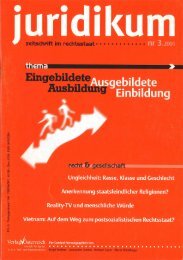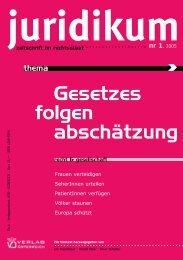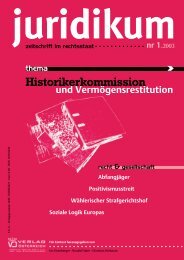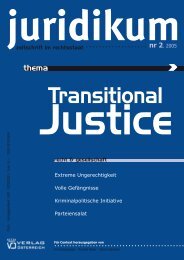Download - juridikum, zeitschrift für kritik | recht | gesellschaft
Download - juridikum, zeitschrift für kritik | recht | gesellschaft
Download - juridikum, zeitschrift für kritik | recht | gesellschaft
Erfolgreiche ePaper selbst erstellen
Machen Sie aus Ihren PDF Publikationen ein blätterbares Flipbook mit unserer einzigartigen Google optimierten e-Paper Software.
thema<br />
The United Nations Convention on the Elimination of All<br />
Forms of Discrimination Against Women (CEDAW) constitutes<br />
the most comprehensive and important international instrument<br />
for the non-discrimination and equality of women.<br />
It obliges states parties to eliminate discrimination of women<br />
in all spheres of life through legal, policy and programmatic<br />
measures, de jure and de facto. Adopted by the UN General<br />
Assembly in 1979, 185 states have ratified the Convention<br />
or acceded to it. Austria ratified the Convention in 1982. 1 Its<br />
monitoring body, the CEDAW Committee, has been essential<br />
in developing international human rights law further, especially<br />
relating to violations of women’s human rights in the<br />
„private” sphere. 2<br />
Despite its theoretical and practical importance<br />
for developing and interpreting non-discrimination<br />
and equality norms and policies in Austria, such as<br />
the role the Convention played in the amendment of<br />
the Federal Constitution in 1998 (Article 7 para 2<br />
B-VG) 3 , or for the introduction of temporary special<br />
measures through quota provisions aimed at ending<br />
the underrepresentation of women, the scope of<br />
rights granted by it are still relatively unknown in<br />
Austria, even among legal professionals. As primary<br />
actors in the implementation of anti-discrimination<br />
provisions, legal professionals have been listed as a<br />
target group of Austria’s obligations as a state party<br />
to the Convention 4 because of their importance in<br />
ensuring de-facto equality of women through nondiscriminatory<br />
implementation of legal provisions<br />
in general.<br />
This article will provide a brief introduction to<br />
the concept of discrimination under the Convention as well as<br />
Austria’s obligations as a state party, with a particular emphasis<br />
on implications for legal professionals. While the status of<br />
the Convention is non-self-executing, its Articles 1-4, defining<br />
discrimination and states parties obligations generally, were<br />
passed with qualified majority in Austria. 5 The implementation<br />
mechanism of the Convention consists of a reporting procedure<br />
(Article 18) 6 and the additional procedures provided<br />
for by the Optional Protocol to the Convention, the individual<br />
communications procedure and the inquiry procedure.<br />
1. Discrimination: de jure, de<br />
facto, all spheres of life<br />
The concept of discrimination laid down in the Convention is<br />
remarkable in a number of ways. It moves beyond guarantees<br />
of equality and equal protection before the law in other legal<br />
instruments and demands of states parties to achieve equality<br />
between women and men in all aspects of political, social,<br />
economic, and cultural life – de jure and de facto.<br />
Article 1 defines discrimination as „any distinction, exclusion<br />
or restriction made on the basis of sex which has the<br />
effect or purpose of impairing or nullifying the recognition,<br />
enjoyment or exercise by women, irrespective of their marital<br />
status, on a basis of equality of men and women, of human<br />
rights and fundamental freedoms in the political, economic,<br />
social, cultural, civil or any other field.”<br />
The following aspects are noteworthy: Firstly, it connects<br />
Familiar with<br />
CEDAW Yet?<br />
Austria – 25 Years After Ratifying<br />
the Convention on the Elimination of<br />
All Forms of Discrimination Against<br />
Women<br />
Karin Tertinegg<br />
·································<br />
the principle of non-discrimination of women to the enjoyment<br />
of all human rights and fundamental freedoms by women, de<br />
jure and de facto. Non-discrimination is thus clearly articulated<br />
as a substantive norm, emphasising the importance of a<br />
particular result. Secondly, the definition prohibits discrimination<br />
against women on the basis of sex, covering both sex<br />
and gender aspects of discrimination against women. Not only<br />
direct forms of discrimination of women based on (biological)<br />
sex are covered, but also formally gender-neutral provisions<br />
and practices having the effect or purpose of discriminating<br />
women. Thirdly, the wording „on a basis of equality of men<br />
and women” challenges the traditionally applied concept in<br />
international and national anti-discrimination law that antidiscrimination<br />
means adaption to male predominant structures<br />
and norms. 7<br />
1) Konvention zur Beseitigung jeder Form von<br />
Diskriminierung der Frau, BGBl Nr. 443/1982,<br />
http://www.frauen.bka.gv.at/site/5548/default.aspx<br />
(18 December 2007). At the time,<br />
Austria made two reservations regarding its<br />
obligations under Article 7 lit b (access of<br />
women to the armed forces) and Article 11<br />
(prohibition of night work of women). The first<br />
reservation has been withdrawn entirely, the<br />
second partially.<br />
2) For an overview, see Schöpp-Schilling/Flinterman,<br />
The Circle of Empowerment. Twentyfive<br />
Years of the UN Committee on the Elimination<br />
of Discrimination Against Women (2007).<br />
See also Byrnes/Graterol/Chartres, State Obligation<br />
and the Convention on Elimination of<br />
All Forms of Discrimination against Women.<br />
University of New South Wales Faculty of Law<br />
Research Series. Working Paper 48 (2007),<br />
Lacey, Feminist legal theory and the rights of<br />
women, in: Knop (ed), Gender and Human<br />
Rights (2004) 14-55, Holmaat/Tobler, CEDAW<br />
and the European Union’s policy in the field of<br />
combating gender discrimination, Maastricht<br />
Journal of European and Comparative Law<br />
(MJ) 2005, 399-426.<br />
3) BGBl I 68/1998.<br />
4) CEDAW Committee, ‚Concluding Comments<br />
regarding Austria’s latest (Sixth) periodic report,<br />
UN Doc CEDAW/C/AUT/CO/6 (2007),<br />
http://www.frauen.bka.gv.at/site/5551/default.aspx<br />
(18 December 2007).<br />
5) They are thus – as „Verfassungsbestimmungen”<br />
– part of Austrian constitutional<br />
law.<br />
6) Article 18 CEDAW imposes a reporting obligation<br />
on state parties. The inter-state procedure<br />
provided for in Article 29 has, to date,<br />
not been utilized.<br />
7) Holmaat/Tobler, MJ 2005, 403.<br />
Seite 38 <strong>juridikum</strong> 2008 / 1
















